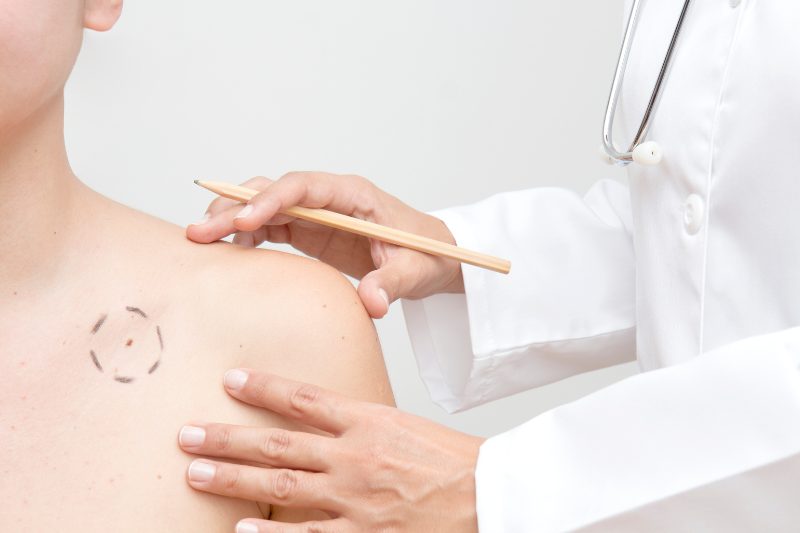Mohs Surgery
Mohs Surgery offers the hightest chance of a cure (up to 98%) of some skin cancers, particularly Basal Cell Carcinomas (BCCs) while ensuring the amount of skin removed is kept to a minimum.

Introduction
In the 1930’s, Dr Frederick Mohs, from Wisconsin USA, first conceptualized and then developed his treatment for skin cancer. The technique has since come to be known as “Mohs Surgery” as due recognition for Dr Mohs’ outstanding contribution to the field of skin cancer treatment.
What is Mohs Surgery?
Mohs Surgery is a highly specialized treatment for the total removal of skin cancers. The visible component of the cancer is surgically excised and then subjected to microscopic analysis whilst the patient waits. Any residual positive areas for cancer are identified and subsequently removed. This process continues until all the cancer cells are cleared. Mohs surgery allows for cancer cells to be fully and accurately tracked without guesswork until they are completely removed.
Why is it important that all cancerous cells be removed?
If cancer cells are left behind at the time of initial surgery, there is a very high chance that the cancer will recur. When this happens it will frequently grow for a substantial period of time hidden invisibly underneath the previous surgical scar. This makes the subsequent treatment of the recurrent cancer much more extensive and difficult.
When is Mohs Surgery recommended?
Mohs surgery is ideal when a skin cancer:
- Is present in a difficult site, where the conservation of as much normal tissue is critical as on the face and especially around the nose, eyes, lips and ears.
- Has recurred after previous treatment(s)
- Has been incompletely excised after initial surgery
- Is discovered to be a certain microscopic type on initial biopsy
What at the advantages of Mohs Surgery?
- It ensures that all cancer cells are removed
- As much healthy skin as possible is preserved.
- The cure rates are approximately 98% - higher than with any other mode of treatment
The Mohs Surgery procedure.
Surgery
The area to be treated is first numbed with local anaesthetic and the visible cancer is removed. A dressing is applied to the wound and the patient returns to a waiting area.
Tissue Mapping
While the patient waits, the removed tissue is precisely oriented and then divided into small sections and the edges marked with colored dye and a tissue map is drawn. The tissue is then handed to the laboratory technician
Tissue processing and examination
The tissue is frozen and cut by the technicians, then mounted on to microscope slides and stained using highly specialized chemicals to identify the different cell types. The doctor then examines the tissue under the microscope to see whether any residual cancer cells can be identified.
Further Surgery
If there is any residual cancer, the wound is re-anaesthetised and further tissue corresponding precisely to the area of positivity is excised and again microscopically checked. This process continues until the Mohs Surgeon is satisfied that no cancerous cells remain.
Wound repair
Once the cancer is shown to be completely removed the patient wound is repaired.
There are many ways in which the post Mohs Surgery wound can be repaired including
- Granulation (“healing by itself”)
- Simple side to side closure
- Skin flaps where adjacent skin is utilized to cover the defect.
- Skin graft
- Combinations of the above
- Occasionally the wound may be repaired by another specialist of the cancer if it involves a site requiring a special expertise
Postoperatively
- Once the wound has been repaired the patient is discharged home
- The patient will usually return at one week for removal of stitches and thereafter on an as required basis.
Final outcome
Almost certainly following Mohs Surgery the cancer will be cured. The final functional and cosmetic outcome is usually excellent
Who performs Mohs Surgery?
Dermatologists who have undertaken post specialist Fellowship training in Mohs Surgery and who are officially sanctioned by the American College of Mohs Surgery and/or the Australasian College of Dermatologists.
REMEMBER- MOHS SURGERY OFFERS THE HIGHEST CHANCE OF CURE AND WITH SMALLER / EARLIER CANCERS THE MAXIMAL DEGREE OF NORMAL TISSUE PRESERVATION
